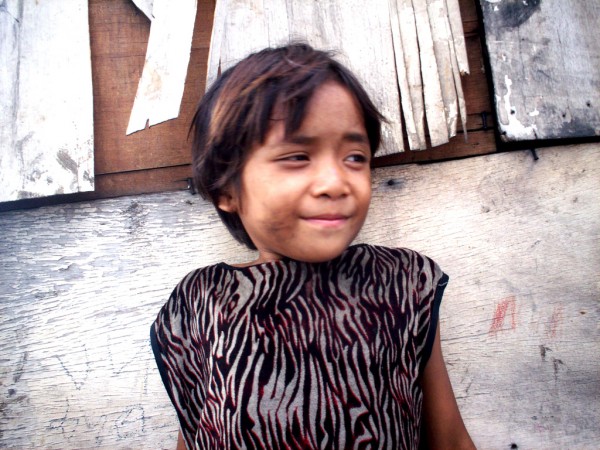Wispy clouds intersect with urban infrastructure during the last moments of a sunset in Manila, the capital of the Philippines. Indigenous political party signs posted on rooftops. A makeshift squatter’s house isolated in an expanse of garbage, one of innumerable brutal conclusions of an ongoing history of neo-colonial relations. A girl, maybe five years old, trying to smile for the camera as her family collects this garbage for their livelihood.
These are some of the moments captured on film in the Philippines by Stefan Christoff. On Movements in Manila is a photography exhibit on display at Kaza Maza in Montreal which emerged out of Christoff’s travels to the Philippines for a international observers mission to Manila during the 2007 elections in response to the wave of political killings targeting progressive movements in the Philippines.
On Movements in Manila is a tragic and beautiful visual representation of the ordinary people who are the end product of neo-colonial exploitation through economic institutions like the WTO and IMF, and the state corruption that is instated to protect these interests. Behind each image lies the history of violence that has been perpetrated upon Filipinos. This memory has largely disappeared from the US historical narrative, but the occupation of the Philippines was one of the first imperialist experiments of the US in the methods of occupation and subjugation.
From 1898 to 1945, direct colonial rule was responsible for the deaths of over one million Filipinos, and puppet regimes answered to U.S. governors as U.S.-trained military was used to control political and economic interests. Since the nominal independence that was achieved for the Philippines in ’46,the only difference in these dynamics is that the country now labels itself a republic. The effects of the World Trade Organization and other international agreements that have deregulated and privatized markets for foreign capital are felt on an hourly basis by the hunger of the majority of Filipinos who can no longer purchase rice. These circumstances are entrenched and enlarged by the Asian-Pacific Economic Cooperation (APEC) agreements.
Joey Calugay from the Centre for Philippine Concerns, a sponsor of On Movements in Manila, elaborates on the factors that cause most Filipinos to live on two dollars a day: “The southern island of Mindanao is fertile enough to feed the entire Philippine population three times over. Why then is there mass hunger in the Philippines? Most arable lands are controlled by an elite oligarchy that leases them to foreign monopoly corporations for export crops or industrial free trade zones. The Philippines is a stopover on the big conveyor belt of corporate globalization. Recent reports of interest and exploration for offshore drilling by U.S. corporations off of Mindanao can help to explain why an average of 6,000 U.S. troops per year are operating mostly on the southern island.”
This violence against Filipinos is not only outside of the borders of Canada, however. Canada has a long history of exploiting the uncertain conditions of migrants in order to use them as wage slaves under the threat of deportation; a phenomenon that has accelerated under Immigration Minister Jason Kenney.
The migrant worker situation for most Filipinos should make every Canadian citizen ashamed, with the domestic worker Live-in Caregiver Program being only one facet of this horrendous migrant labour exploitation. As Canadian multinationals are exploiting the cheap Filipino labour pool for the enormously destructive project of the tar sands domestically, Canadian mining corporations are plundering indigenous resources in the Philippines.
From the initiation of western colonial domination, indigenous resistance has been strong and inspiring. The continued persistence and growth of this resistance has been responded to with an unsuccessful attempt to quell this organizing through the murder of activists and journalists, coverage of which has largely been absent from western mass media.
Since Arroyo took office in 2001, more than 1,000 political killings have been attributed to paramilitary and police forces, along with over 200 abductions and disappearances, and countless human rights violations.
In some documented cases these murders have been traced back to Canadian mining operations. Calugay explains the systems by which foreign elite interests are disguised behind paramilitary death squads; “The security forces hired by Canadian mining corporations are hard to link to the political repression and violence directly because they work insidiously under subsidiaries; corporations they invest in which have a Philippine name.”
Canadians have the privilege of not risking assassination for taking to the streets in the pursuit of justice. It is our responsibility to create an outcry against these grave violations of humanitarian law, and expose the complicity of Canadian corporations and government policies in these injustices.
As Calugay stated with hope, “Despite all repression, there is no end to the strength of the people’s mass movement. They are rising up, organizing, and growing in strength to build a better world with genuine democracy despite the political threat, militarization, and counter insurgency they have faced since the time of Marcos. The international community has a role to play, as do all peace loving people, to denounce political repression and to support people’s sovereign rights to self-determination in the Philippines, and elsewhere in the world.”
The photographs of Stefan Christoff reveal these moments of hope and profound dignity which emerge from the struggle against these elite interests that would much prefer complacency and obedient acceptance.
Stefan Christoff’s photography exhibition will be at the Kaza Maza in Montreal throughout February, click here for more info.



